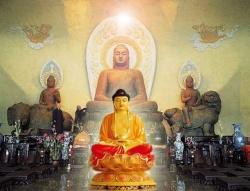Difference between revisions of "Four Buddhist schools ( Philosophical)"
Jump to navigation
Jump to search
| Line 12: | Line 12: | ||
[[sems-tsam-pa]], | [[sems-tsam-pa]], | ||
[[dbu-ma-pa]] in [[Tibetan]]). | [[dbu-ma-pa]] in [[Tibetan]]). | ||
| + | |||
| + | The two [[Hinayana]] schools of [[Vaibhashika]] ([[Great Exposition]]) and [[Sautrantika]] ([[Sutra]]) and the two [[Mahayana]] schools of [[Cittamatra]] ([[Mind Only]], also called [[Yogachara]] or [[Practice of Yoga]]) and [[Madhyamaka]] ([[Middle Way]]), of which there are two subschools, [[Svatantrika]] ([[Autonomist]]) and [[Prasangika]] ([[Consequentialist]]). | ||
| + | |||
| + | |||
</poem> | </poem> | ||
{{E}} | {{E}} | ||
Latest revision as of 16:21, 23 August 2018
The four Buddhist schools are;
Vaibhashika,
Sautrantika,
Chittamatra, and
Madhyamaka
(bye-brag-smra-ba,
mdo-sde-pa,
sems-tsam-pa,
dbu-ma-pa in Tibetan).
The two Hinayana schools of Vaibhashika (Great Exposition) and Sautrantika (Sutra) and the two Mahayana schools of Cittamatra (Mind Only, also called Yogachara or Practice of Yoga) and Madhyamaka (Middle Way), of which there are two subschools, Svatantrika (Autonomist) and Prasangika (Consequentialist).
